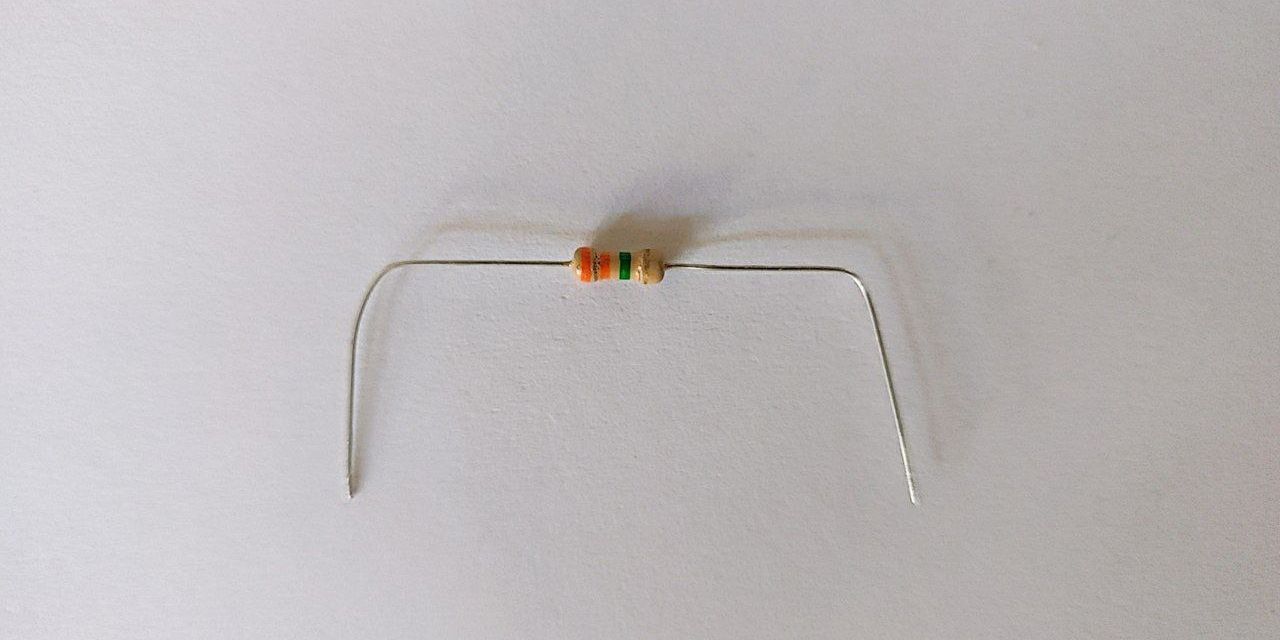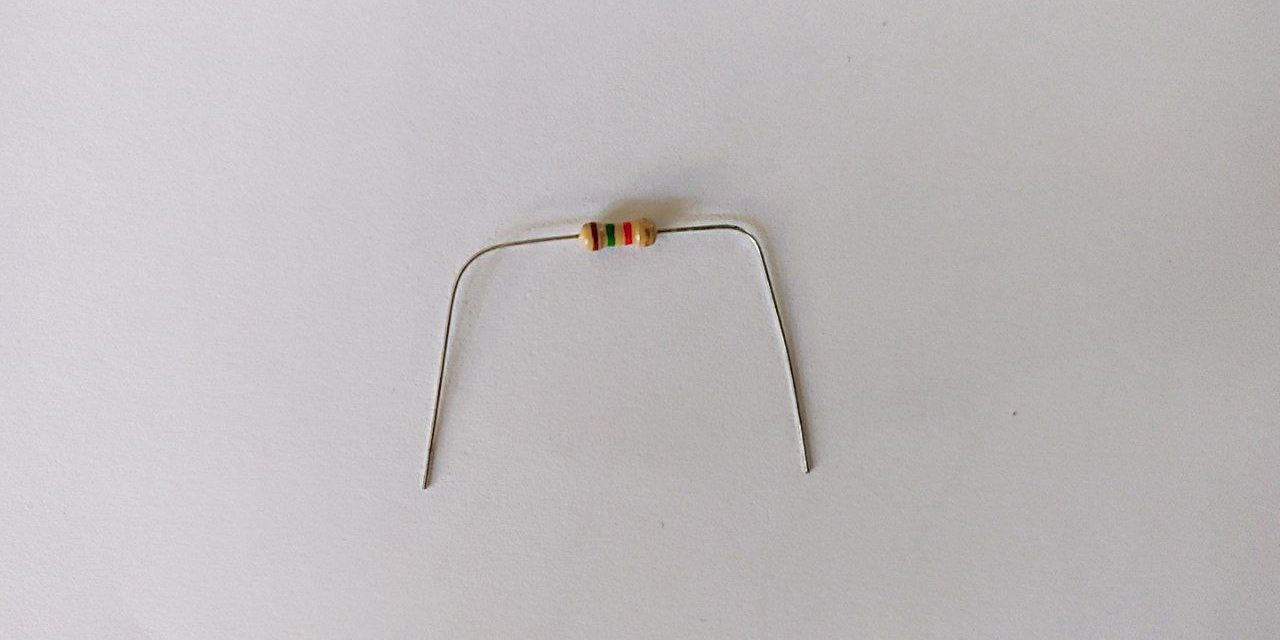How to Read Resistors Number to Color Code
The common fixed resistor comes with a variety of colorful bands. Do they mean annihilation? Yes, they do! These colors give vital information about the resistor. Read this commodity to larn what they mean.
What Is a Resistor?
A resistor is an electrical component that is used to create resistance in circuits. This resistance can exist utilized in many ways, like dividing the voltage or reducing the current. There are many types of resistors. However, the one that we're going to work with in this article is the well-nigh common one: the 4-band fixed resistor. A resistor works by changing the three factors in the resistance formula. R = pL / A Based on this formula, to create and increase resistance, you lot can:
- Increase the p or resistivity by using a less conductive material.
- Increase the L or length.
- Reduce the A or cantankerous-section area.
A fixed resistor basically does all iii of these at the same fourth dimension. The resistor uses carbon, which is a less conductive cloth, and has a thin long structure that increases the length while reducing the cross-section area.
Resistor Bands
Stock-still resistors have color bands to inform you lot of their properties. Each band adds one piece of information to the whole flick, depending on its position and its colour. In that location are 3 major types of stock-still resistors:
- 4-ring: This is the most common type of resistor. The first ii bands betoken the significant digits, the third band indicates the multiplier, and the 4th band indicates the tolerance.
- v-ring: This is similar to the 4-ring, except that it has three bands for significant digits. The fourth band indicates the multiplier and the last band indicates the tolerance.
- 6-band: This one introduces an entirely new ring type. Aside from all the bands in the 5-band resistor, this resistor as well has a sixth band, indicating the temperature coefficient.
You'll have to put together the numbers each band represents to summate the resistance.
| iv-Band | 5-Ring | 6-Ring | |
|---|---|---|---|
| 1st Band | Beginning digit | Commencement digit | First digit |
| 2nd Ring | 2d digit | Second digit | 2d digit |
| 3rd Band | Multiplier | Third digit | Third digit |
| fourth Band | Tolerance | Multiplier | Multiplier |
| fifth Band | – | Tolerance | Tolerance |
| 6th Ring | – | – | Temperature coefficient |
The Digit Bands
The digit bands utilise the same color codes for the digits they want to express. In a 4-band resistor, the digit bands are the offset two bands, and in a 5- or 6-band resistor, the first three will be the digit bands. The digit bands can exist in any of the 10 colors, which stand for the digits 0 to nine. The offset digit, however, can't be black (which represents nil) since information technology would be quite pointless.
| Color | Value |
|---|---|
| Chocolate-brown | 1 |
| Ruby-red | ii |
| Orange | 3 |
| Yellow | four |
| Green | five |
| Blue | 6 |
| Violet | vii |
| Grayness | 8 |
| White | nine |
| Black (never in the first band) | 0 |
In one case you put the digits each color represents together, you lot have the significant digits for your resistance value in ohms. All that remains is to observe out the multiplier.
The Multiplier Ring
The multiplier band indicates the value your digits are multiplied with. This is the third band in a 4-band resistor type and the 4th band in 5- or 6-band types.
| Color | Value |
|---|---|
| Blackness | x1 |
| Brown | x10 |
| Blood-red | x100 |
| Orangish | x1,000 |
| Yellow | x10,000 |
| Green | x100,000 |
| Blue | x1,000,000 |
| Violet | x10,000,000 |
| Gray | x100,000,000 |
| White | x1,000,000,000 |
For example, if yous take an orangish multiplier band it means your resistor is in the kilohm scale.
The Tolerance Band
Tolerance is basically the mistake margin of your resistor. This means that your resistor won't always be resisting exactly with the value information technology's supposed to. A tolerance of 10% on a 100 ohm resistor ways that the resistance can exist anywhere from 90 to 110 ohms.
| Color | Value |
|---|---|
| Brown | ±1% |
| Red | ±ii% |
| Orange | ±three% |
| Yellow | ±4% |
| Green | ±0.5% |
| Blue | ±0.25% |
| Violet | ±0.10% |
| Gray | ±0.05% |
| Gold | ±five% |
| Silver | ±ten% |
The to the lowest degree tolerance in typical resistors is ±0.05%, represented by gray, and the most is ±ten%, represented by argent. Silverish and gray may sound similar they can be mistaken for ane some other, only the metal glow of the silver band color hands distinguishes it from grayness. The tolerance band is the final band in a iv-band resistor blazon and the fifth band in a 5- or 6-band type.
The Temperature Coefficient Ring
The 6-ring resistors have a special final band that indicates the temperature coefficient of the resistor. Resistance changes when the temperature changes; the amount (how much the resistance changes per each unit of temperature) and direction (whether the resistance increases or decreases) both depend on the material. The common stock-still resistors are made of carbon and their resistance decreases with estrus. The sixth band, combined with the offset four bands, tin can tell yous how much exactly it changes per temperature unit.
| Color | Value |
|---|---|
| Black | 250 ppm/ºC |
| Chocolate-brown | 100 ppm/ºC |
| Red | 50 ppm/ºC |
| Orange | 15 ppm/ºC |
| Yellow | 25 ppm/ºC |
| Green | xx ppm/ºC |
| Bluish | 10 ppm/ºC |
| Violet | 5 ppm/ºC |
| Greyness | ane ppm/ºC |
The temperature coefficient is expressed in ppm/ºC, which is parts per million per degree Celsius. To translate this to ohm/ºC, all you need to do is to multiply the temperature coefficient with the resistance of the resistor, and then split it by a one thousand thousand. This will give you a value in ohm/ºC which tells you how much the resistance volition drop with every degree Celsius of increased temperature.
Putting Information technology All Together
When it comes to resistor bands, each color represents a number. The number a colour represents depends on the band'south position. For instance, in a iv-band resistor, violet on the showtime band means seven, whereas violet on the 3rd band ways x10,000,000. To translate the resistor band colors, you lot'll take to consider the color and the sequence. Allow's put it all together with ii examples.
Resistor Case one

Here's a simple 4-band resistor. Let'southward run across if we can determine its backdrop just by looking at it.
- The beginning band: The offset band is in orange, and according to the tabular array in the previous sections, orangish stands for 3.
- The 2d ring: The second band is in orange also, so this is another 3. Then far nosotros take 33.
- The third band: Since this is a iv-band resistor, the third band is the multiplier. A greenish multiplier band means x100,000. By now nosotros know that we have a three,300,000 ohm or 3.3 megohm resistor.
- The fourth band: The terminal band in a 4-band resistor is the tolerance band. This is going to indicate the error margin for your resistor. The fourth band in this resistor is gold, and that means ±5%. Golden and silver tolerance bands are the nigh mutual.
And then and so, the resistor in the picture is a iii.3 megohm resistor with a tolerance of ±5%. The tolerance combined with the resistance value ways that the minimum resistance for this resistor is three.135 megohms (-five%) and the maximum is 3.465 megohms (+5%).
Resistor Example 2

Hither's another iv-band resistor. The waypoint is just similar the previous example:
- First ring: The starting time digit band is dark-brown, which represents one.
- Second ring: The second digit band is green, which represents 5.
- Tertiary band: The multiplier band is orangish, which represents x1,000. And then far we have 15,000 ohms (15 kilohms).
- 4th ring: The tolerance band is golden, like the previous example, which means the tolerance is ±5%.
So if you put all this information together, y'all'll know that this is a 15 kilohm resistor. The minimum resistance is 14.25 kilohms (-5%) and the maximum resistance is 15.75 kilohms (+v%).
No Demand for an Ohmmeter
You don't ever demand to use an ohmmeter to find out the resistance of a resistor. If your resistor has color bands on information technology, you tin can tell how much resistance it's packing but by simply observing it. Now that you know what resistor you have, it's the right time to solder it into your circuit.
About The AuthorSource: https://www.makeuseof.com/how-to-read-resistor-color-codes/

0 Response to "How to Read Resistors Number to Color Code"
Post a Comment